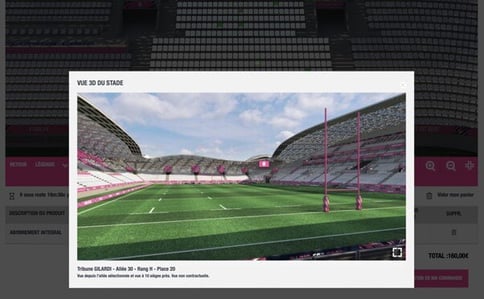One of the most critical areas to focus on for boosting sales is the buying experience. Do you want to encourage customers to purchase tickets on your website? Offer them a smooth, reassuring, and frictionless experience—in essence, the best possible experience. Aim to match the standards set by digital giants like Amazon, Booking.com, or Airbnb. Your customers should easily find the information they seek and be able to complete their purchase with minimal clicks.
To optimize this process, test your customers’ journey. How many visitors land on the page? How many convert into buyers? Count the clicks and strive to eliminate unnecessary steps. Simplify your text, avoid capitalized red-lettered blocks, and make the buttons that customers need to click on to purchase tickets more visible and intuitive. If you’re considering changes, try A/B testing to determine the best version of a webpage.

Example of 3D stadium immersion in the purchasing process
4. Optimize your marketing efforts
Your teams are often tasked with heavy workloads, which is why they need to work efficiently to achieve their objectives. Taken from the MKT1 newsletter, we recommend the GACC marketing method (Goal, Audiences, Creativity and Channels). This approach allows you to score each of your marketing activities
(offer and content creation) and ensures that every action you take follows a specific objective within a broader communication plan.
To define the GACC for each creation in five minutes, ask these questions :
- Goal: What performance indicators are you trying to improve? What objective does this support?
- Audiences: Who is your target audience? What profile are you trying to reach? Are you targeting prospects, customers, or both?
- Creativity: How does this add value for your audience?
- Channels: Where will this content be distributed? How will it be delivered?
In summary, start by defining your objectives and creating a marketing roadmap or calendar. For every piece of content you produce (offers, articles, videos, etc.), write a GACC, create the content, and then distribute it.
In today's sports organizations, reaching new audiences and retaining existing ones are central goals of any marketing strategy. To achieve these objectives, it is essential to access data that helps you understand your audience, particularly their interests, purchasing history, and socio-demographic information.
To achieve these objectives, CRM is a proven solution for centralizing and leveraging your data.